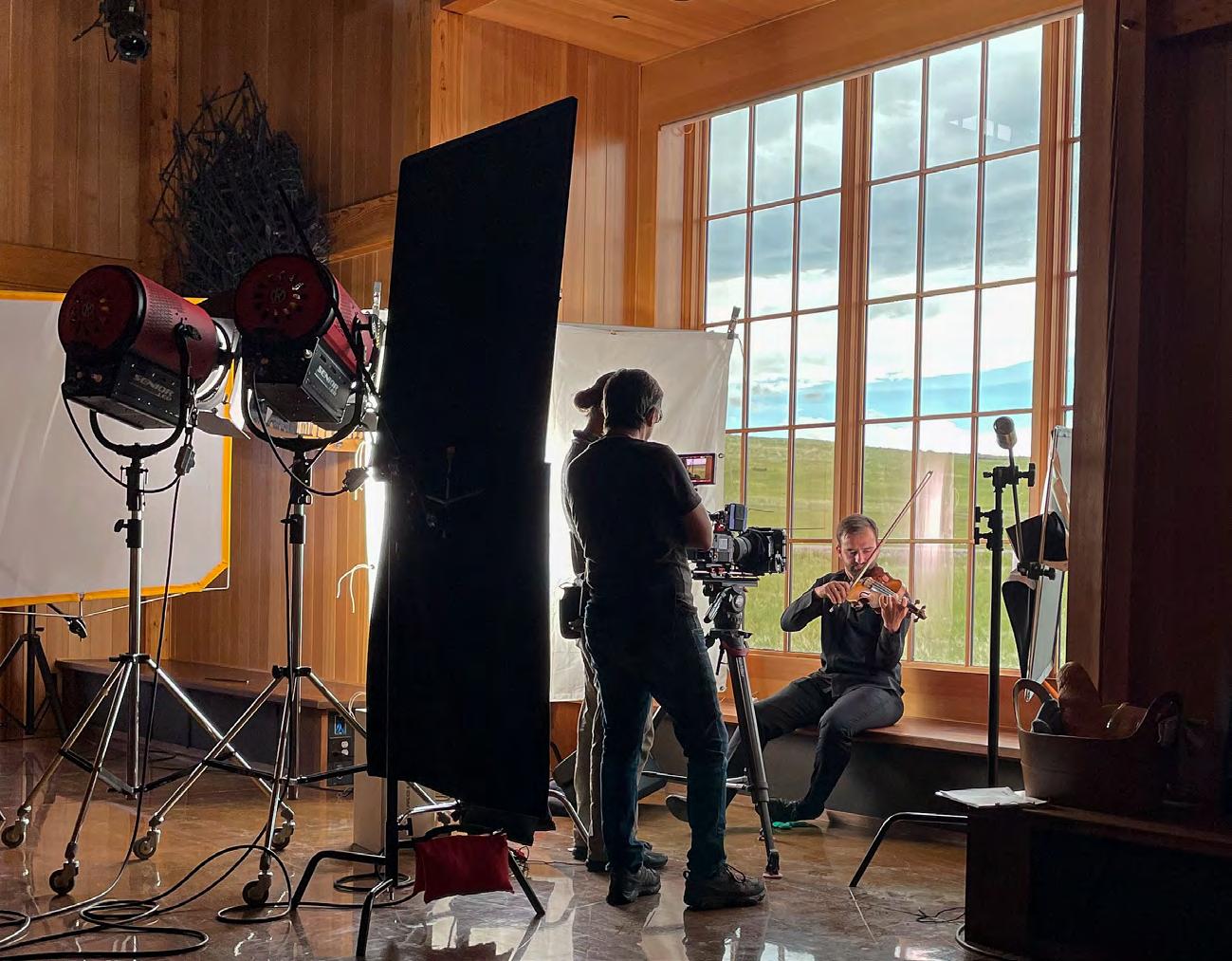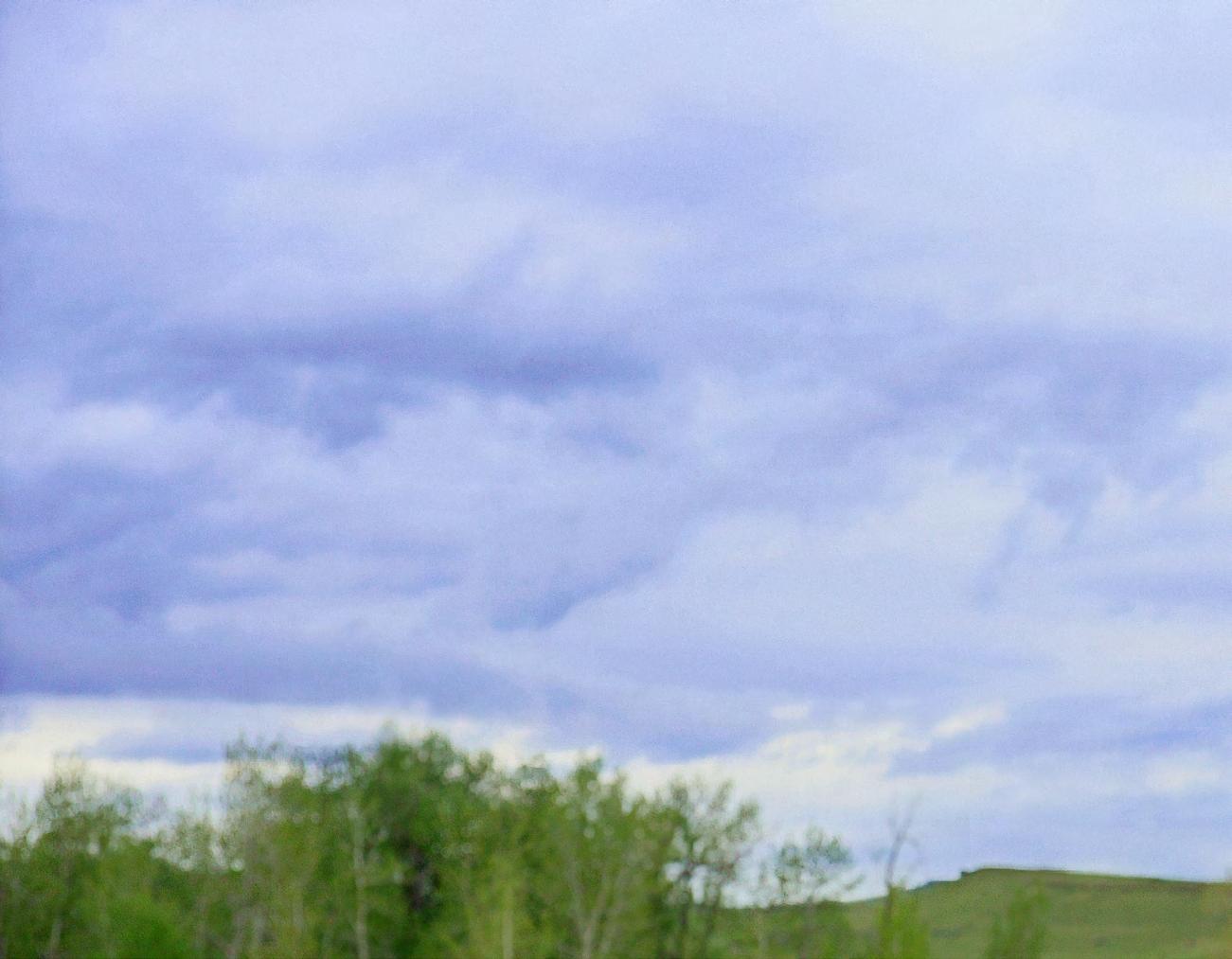William Hagen at Tippet Rise





The “Danse rustique” from Ysaÿe’s Fifth Sonata is a marriage between the seemingly disparate worlds of Ysaÿe’s refined classical background and a rustic folk dance tune. Written on the page with the precision and thoughtfulness of the great classical composers, in performance it sounds like the spontaneous improvisations of a folk musician.
As I walked from my cabin to the Olivier Music Barn for the recording session, the sights, smells, and sounds of the expansive landscape at Tippet Rise brought the “rustique” character of this music to life for me in a spectacular way. A breeze carried the beautiful scent of the cottonwoods my way and made the spring wildflowers dance amongst the grass as birdsong cut through the sound of shimmering leaves. A “rustic dance” of the Tippet Rise landscape. I find it very special to think that a Belgian composer’s music written a century ago and a continent away could feel so natural and fitting thousands of miles away in Montana.

This was an unforgettable project that I’ll always cherish.
—William HagenYsaÿe’s tone and his charisma brought a humanism to the mathematical algorithms of even serious music like Bach, as cairns suggest human forms in the fog to Inuit people in Alaska.
This film is a tribute to those cairns, to the immanence buried in meadows, to the spirits in scales, to the Thunderers of clouds and keybeds, to the deeper shadows buried in the highly rational and cerebral virtuosity of Ysaÿe’s rustic dance.
The video technique pays homage to the pathetic fallacy, as Bobby Darin’s song “Listen to the Rhythm of the Rain” suggests that rain and Bobby’s tears are entwined.
The pathetic fallacy was coined by the great art critic John Ruskin in 1856 in the third volume of his work Modern Painters, to criticize the tendency among the Romantic poets like Keats and Shelley to attribute human qualities to nature.
At Tippet Rise, though, Symbolist conceits assume a more realistic identity, and nature plays a visible role in the emotions of both audience and musicians. The pianist Lucas Debargue asked us to tour the ranch before his concert so he could evoke it later in his playing.
In the deeper structures of the sky, quantum physics today proposes a wormhole which links disparate timelines in universes which are traveling at different speeds. ESP and premonitions are thus scientific breaches in a wall which separates us from other, equally valid realities.
4 Eugène Ysaÿe: Sonata No.5 for Violin, Op. 27


Our video team, in collaboration with the brilliant Utah virtuoso William Hagen, have thus devised a program where music transmutes into nature, and vice versa. Using the linguistic technique hypallage, Horace speaks of the angry crowns of kings, meaning the kings are angry, not the crowns. He misplaces his modifiers, transporting feelings from people to things. Virgil and Proust also use this transference to change dimensions linguistically. Musical grammar transfers an angry sky to harsh violin chords. Sky and violin are transposed: a preamble of rolling thunder under roiling skies anticipates the musical fireworks to follow. Dark clouds themselves transition through the darkness of the theme to the backdrop of the Beartooths from inside the Olivier Music Barn as the rustic dance begins.
Such correspondences aren’t only scientific and cinematic; they exist throughout history in animism and immanence, where society, as the Duke says in As You Like It: Finds tongues in trees, books in the running brooks, Sermons in stones, and good in everything.
Indian and African cultures believe there are spirits in trees, as Francis Kéré’s pavilion, Xylem, is a tree taken apart. Aside from animism, Francis celebrates also the practical aspect of trees: in Burkina Faso people meet their girlfriends under trees, community elders confer under trees; trees provide shade against the sun; they hold water in the soil with their roots. They are also symbols of the forests we are losing every year.
In Canada, Greenland, and Alaska, the Inuit and other peoples of the Arctic understand that rocks can be mistaken for people in the mist, as John Luther Adams’ piece, Inuksuit, is a conduit where sounds and emotions originate in cairns, which mark the threshold of the spiritual landscape of the Inummariit — the Inuit who know how to survive on the land. Inuksuit, or cairns, indicate a place where life is renewed, where spirits radiate from stones, where decisions are made, and where festivals are held.
In the 20th Century, the Ojibwe communities of Canada conceive of weather as personal. Storms are people, ‘Thunderers,’ sounds that talk between the clouds. Wind isn’t just a sound, though, but a person. In the same way, musical notes create entire worlds in the space of a short piece, as in
Eugène Ysaÿe’s Sonata No. 5.
Ysaÿe played in a beer hall band so renowned that Liszt, Joachim, Anton Rubinstein, Clara Schumann all came to hear it. It eventually outgrew the bierstube and became the Berlin Philharmonic Orchestra.
Ysaÿe was a great virtuoso and composer of brilliant showpieces, his sonatas being an homage to the Etudes of Paganini, the encore showpieces of Sarasate and Saint-Saëns; but he was more than that; as a teacher, Ysaÿe taught the great string players (Primrose, Milstein, Gingold ) who in the 1950s and 60s passed on to us his goal of summoning up intangible feelings with tangible notes.
Like Fauré and Debussy, his composition was influenced by Baudelaire. He was a Symbolist, where notes stood in for the essences of, for instance, night and snow. At his death he was working on a piece called “the virgin of the stones,” hinting at sermons in stones, spirits in trees.
8 Eugène Ysaÿe: Sonata No.5 for Violin, Op. 27

10
 Eugène Ysaÿe: Sonata No.5 for Violin, Op. 27
Eugène Ysaÿe: Sonata No.5 for Violin, Op. 27
This film, then, evokes chords deeper than its surface. In our video, William begins the second movement of the sonata, the Dance rustique, surrounded by the Ojibwe Thunderers. When the music calms at 00:45, William finds himself transported to the lush aspen grove around Francis Kéré’s Xylem, his deconstructed tree.
When atoms change orbits, they release energy. William switches levels as a new energy courses into the music. As the theme develops at 1:04, William progresses up the hill to the fields past the Huffman cabin, built by early 1900s settlers on the Johnson Ranch quadrant of Tippet Rise.
At 1:21, William is back in the barn, the lawns and snowcapped Beartooths behind him out the window, although this time they are almost painted on the glass by the brushstrokes of condensation.
At 1:37, cumulus clouds roll in rapidly and thunder is heard as the first theme subsides.
At 1:45, the violin begins complex variations in thirds which question and take apart the structure of the original theme. For this very intellectual moment, William plays in the dark, so that sight doesn’t distract from the music.
Scales lead back to the outdoor storm at 2:43, as the music becomes expansive, sounding more like a concerto than a sonata: clouds scud, break up, and darken. This is an orchestral moment. The violinist and the sky begin to merge as night grows.
At 3:29, a dreamlike passage moves the piece into an ethereal realm, removed from issues of technique and virtuosity. At 3:37, the dark of the barn returns as the music turns meditative and fugal, falling down the keybed in plucked strings (one of Ysaÿe’s innovations) to the reprise, at 4:14, of the original Roma theme, emerging from the dark of the barn into the broad light of the groves around Patrick Dougherty’s Daydreams.
At 4:34, a sliding chromatic scale plunges us into the coda and, again, as the pace increases, William’s site moves into the higher fields, flashing between dark and light, and then revisiting each of the sites of the short video in a visual fireworks matching the dizzying fingerwork on the violin. The last 45 seconds are a tour de force, the expected brillantine finish to this happy dance of the sky and land.
After the last flourish of the bow, for 10 seconds we hear running water, wind, thunder, and then the deluge: nature’s applause.
The synergistic cinematic style of the film offers a working parallel between music, land, and film, three objective correlatives working together.
The film changes sites as the music changes levels, grounding the Symbolism of Ysaÿe’s dreaming, Romantic age to the austere modern architecture of his Rustic Dance. The film’s style would resonate, I think, with Debussy and with Baudelaire, and we want to thank William and our audio-video team, Monte, James, Kevin, and Jim, for weaving together an imaginative accompaniment to Ysaÿe’s gorgeous showpiece. Their visual dance is more than rustic: it evokes the cycles of the earth itself.
—Tippet Rise co-founder, Peter Halstead 12 Eugène Ysaÿe: Sonata No.5 for Violin, Op.


William Hagen has performed as soloist, recitalist, and chamber musician across the United States, Europe, Asia, and Latin America. In 2022–23, William performs with orchestras around the United States, makes his debut with the Orquesta Filharmónica de Bogotá, and performs as soloist and chamber musician in several countries in Europe.
As soloist, William has appeared with the Chicago Symphony, Chamber Orchestra of Europe, Detroit Symphony, Frankfurt Radio Symphony (HR Sinfonieorchester), San Francisco Symphony, Seattle Symphony, Utah Symphony, and many others around the globe.
As recitalist and chamber musician, William has performed at venues such as Wigmore Hall and the Louvre, and collaborated with artists such as Steven Isserlis, Gidon Kremer, Edgar Meyer, and Tabea Zimmerman, among others. He maintains an active schedule on both sides of the Atlantic, making frequent trips to Europe and cities around the United States to play a wide of repertoire.

In 2020
William released his debut album, Danse Russe, with his good friend and frequent collaborator, pianist Albert Cano Smit. The album is available on all streaming platforms.
A native of Salt Lake City, Utah, William began playing the violin at the age of 4, studying the Suzuki method with Natalie Reed and then Deborah Moench. He studied with Itzhak Perlman and Catherine Cho at the Juilliard School, Christian Tetzlaff at the Kronberg Academy, and was a longtime student of Robert Lipsett, studying with Mr. Lipsett for 11 years both at the Colburn
Community School of Performing Arts and at the Colburn Conservatory of Music. In 2015
William won Third prize at the Queen Elisabeth Competition in Brussels.
William performs on the 1732 “Arkwright Lady Rebecca Sylvan” Antonio Stradivari, and on a violin bow by François Xavier Tourte, both on generous loan from the Rachel Barton Pine Foundation.
Performed by William Hagen
Produced in-house by Tippet Rise Art Center.

Recorded and presented in 8K.
Director / Editor / Colorist: James B. Joyce
Director of Photography: Kevin Richey
Recording Engineers: Monte Nickles, Jim Ruberto
Audio Editing: Monte Nickles, Jim Ruberto
Audio Mix and Mastering: Monte Nickles
Production Stills: Rhema Mangus
Eugène Ysaÿe: Sonata No.5 for Violin, Op.


Recorded June 2, 2022
Recording Engineers: Monte Nickles, assisted by Jim Ruberto
Sound Editor: Monte Nickles
Denoising: Jim Ruberto
Mixing and Mastering Engineer: Monte Nickles
Performer: William Hagen
Producer: Monte Nickles
Recorded in AURO-3D® for immersive playback in 32-bit 384kHz DXD format.
Microphones:
Main array:
Left, Right, Center, Surround L & R: DPA 4041
Height: Front L & R, Rear L & R: DPA 4006
Spot mics on Violin:
Left, Right: AEA N8
Left, Right: Neumann U67
Microphone preamps: Grace Design M108
A/D Conversion: Merging Technology HAPI and HORUS
DAW: Merging Technologies Pyramix
Click on the arrow on your chosen track and listen. Many computers after 2016 can play high-quality sound.

Your computer may not be able to read the chosen track. You can upgrade your sound by adding a converter and headphones (see the lists under FAQs).
Here’s how to attach them to your computer:
To add a converter and headphones

1. Plug the items in: Computer + USB cable + converter + headphones.

2. Double-click on the TRACK you’d like to hear.
3. Gohavlunch while it downloads. It could take five minutes to half an hour, depending on your internet speed.

4. You’ll see the ICON for the track in your downloads window. You can play it from there.
5. If it feels more convenient, drag it to your desktop.
6. Double-click the ICON. You might see a PLAYBACK WINDOW with controls to pause, stop, and play.
7. Figure out how to turn the sound up and down on your computer.
8. Put the SOUND down LOW.
9. Put on the headphones.
10. Push PLAY in the PLAYBACK WINDOW.
11. Turn up the sound until you hear the music comfortably, on both the converter and your computer.
(Note that you may have to turn up your computer’s sound in its PREFERENCES window in its SETTINGS.)
